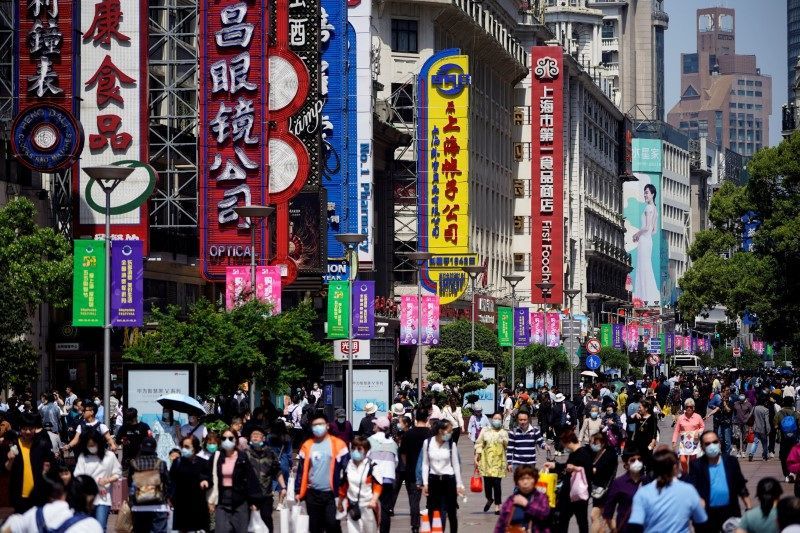China’s population shrank in 2022 for the first time in more than 60 years, a new milestone in the country’s deepening demographic crisis with significant implications for its slowing economy.
The population fell in 2022 to 1.411 billion, down some 850,000 people from the previous year, China’s National Bureau of Statistics (NBS) announced during a Tuesday briefing on annual data.
Analysts said the decline was the first since 1961 during the great famine triggered by former leader Mao Zedong’s Great Leap Forward.
“The population will likely trend down from here in coming years. This is very important, with implications for potential growth and domestic demand,” said Zhiwei Zhang, president and chief economist at Pinpoint Asset Management.
The birth rate also fell to a record low of 6.77 births per 1,000, down from 7.52 a year earlier and the lowest level since the founding of Communist China in 1949. Some 9.56 million babies were born, compared with 10.62 million in 2021 – despite a push from the government to encourage more married couples to have children.
The new data came alongside the announcement of one of China’s worst annual economic performances in nearly half a century, with the economy expanding by just 3% for the year – far below the government’s target – underscoring the steep economic challenges the country faces as its labor force shrinks and its retired demographic grows.
It also follows a UN prediction last year that India will surpass China to become the world’s most populous country in 2023.
Policy solution?
China’s demographic crisis, which is expected to have an increasing impact on growth in the years to come, has been a key concern for policymakers.
Beijing scrapped its decades-long and highly controversial “one child” policy in 2015, after realizing the restriction had contributed to a rapidly aging population and shrinking workforce that could severely distress the country’s economic and social stability.
To arrest the falling birth rate, the Chinese government announced in 2015 that it would allow married couples to have two children. But after a brief uptick in 2016, the national birth rate has continued to fall.
Policymakers further relaxed limits on births in 2021, allowing three children and ramped up efforts to encourage larger families, including through a multi-agency plan released last year to strengthen maternity leave and offer tax deductions and other perks to families. But those efforts have yet to see results amid changing gender norms, the high cost of living and education, and looming economic uncertainty.
Many young people are choosing to marry later or deciding not to have children altogether, while decades of single births has led to the widely-discussed social phenomenon of families with one adult child as the sole caretaker for two parents – squeezing the post 1980s generation, who are expected both to care for elderly parents and raise young children.
The pandemic years added to that stress, as Covid-19 and the Communist Party’s stringent response to the outbreak hit the economy and generated deep political frustration, with some young people rallying around a catchphrase “We are the last generation,” following Shanghai’s punishing two-month lockdown.
Addressing demographic challenges has remained a top political priority, with Chinese leader Xi Jinping pledging to “improve the population development strategy” and ease economic pressure on families during a key speech at the start of China’s five-yearly Party Congress in October.
“[We will] establish a policy system to boost birth rates, and bring down the costs of pregnancy and childbirth, child rearing, and schooling,” Xi said.
“We will pursue a proactive national strategy in response to population aging, develop elderly care programs and services, and provide better services for elderly people who live alone.”
Economic slowdown
China’s elderly make up a fifth of its 1.4 billion people, with the number of those 60 and above expanding to 280 million – or 19.8% of the population – last year, officials said Tuesday. That’s an increase of roughly 13 million people age 60 and over from 2021.
The graying of China’s population follows a similar trajectory playing out in Asia’s developed economies.
Japan and South Korea have also seen their birth rates plummet and populations age and start to shrink alongside their economic development, posing challenges for their governments in supporting a large elderly demographic, while coping with a dwindling workforce.
China’s working-age population peaked in 2014 and is projected to shrink to less than one third of that peak by 2100, while the number of people age 65 and above is projected largely to continue to climb, surpassing China’s working-age population near 2080, according to analysis published by the World Economic Forum last year.
The latest national data shows the number of working age adults continued to shrink – by the end of 2022 making up 62% of the population, down 0.5% from the previous year, with analysts pointing to steep challenges ahead.
“The Chinese economy is entering a critical transition phase, no longer able to rely on an abundant, cost-competitive labor force to drive industrialization and growth,” said HSBC chief Asia economist Frederic Neumann.
“As the supply of workers begins to shrink, productivity growth will need to pick up to sustain the economy’s heady pace of expansion.”
Neumann added that while China’s economic growth would still likely exceed that of developed markets for years to come, it would likely slow “as increases in productivity are unable to fully offset the drag from a shrinking labor force.”
Source:cnn.com











